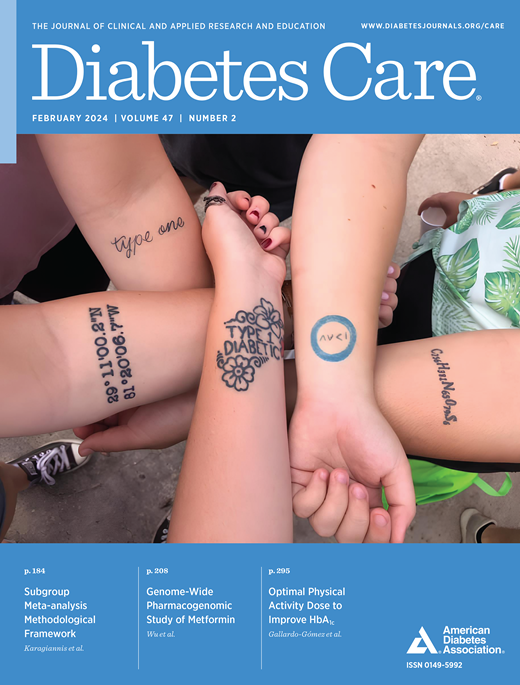Lipidomic Markers of Processed Meat and Unprocessed Red Meat Intake and Risk of Diabetes in American Indians
IF 16.6
1区 医学
Q1 ENDOCRINOLOGY & METABOLISM
引用次数: 0
Abstract
OBJECTIVE To identify lipidomic markers of habitual unprocessed red meat and processed meat intake and evaluate their associations with diabetes risk in American Indians. RESEARCH DESIGN AND METHODS We studied 1,816 participants from the Strong Heart Family Study. Using untargeted liquid chromatography-mass spectrometry, we quantified 1,542 lipids (518 known) in fasting plasma at baseline and follow-up (∼5 years apart). Meat intake was assessed via Food Frequency Questionnaires. Mixed-effects linear regression was used to identify lipids associated with meat consumption. Mixed-effects logistic regression was used to examine whether these lipids were associated with incident diabetes, independent of conventional risk factors, or with longitudinal glucose/insulin metrics. RESULTS Diabetes developed in 66 of 1,076 participants with normal baseline glucose. After multiple testing correction, 15 known lipids, primarily plasmalogens, were associated with unprocessed red meat intake. Three plasmalogens were linked to incident diabetes (odds ratio [OR] 1.32 [95% CI 1.02–1.70] to 1.39 [1.08–1.78] per SD increase in baseline levels) and higher red meat intake. Eight lipids, mainly sphingomyelins, were associated with processed meat intake. Two sphingomyelins were linked to incident diabetes (OR 1.33 [95% CI 1.02–1.75] and 1.36 [1.04–1.80]) and higher processed meat intake. Of 23 meat-related lipids, 20 were associated with altered glucose/insulin metrics, and 11 mediated positive associations between red or processed meat intake and fasting glucose. CONCLUSIONS We identified lipidomic markers of unprocessed red and processed meat consumption. Several lipids were independently associated with increased diabetes risk, potentially by mediating the association between meat intake and glucose metabolism.美国印第安人加工肉类和未加工红肉摄入与糖尿病风险的脂质组学标记
目的鉴定美国印第安人习惯性未加工红肉和加工肉摄入量的脂质组学标志物,并评估其与糖尿病风险的关系。研究设计和方法我们研究了1816名来自强心脏家族研究的参与者。使用非靶向液相色谱-质谱法,我们在基线和随访(间隔~ 5年)对空腹血浆中的1542种脂质(已知518种)进行了定量。通过食物频率问卷评估肉类摄入量。使用混合效应线性回归来确定与肉类消费相关的脂质。使用混合效应逻辑回归来检查这些脂质是否与糖尿病事件相关,独立于传统的危险因素,或与纵向葡萄糖/胰岛素指标相关。结果:1076名基线血糖正常的参与者中有66人发生糖尿病。经过多次测试修正,15种已知的脂质,主要是磷脂原,与未加工的红肉摄入有关。三种缩醛磷脂原与糖尿病的发生有关(比值比[OR] 1.32 [95% CI 1.02-1.70]至1.39[1.08-1.78]/基线水平每SD增加)和摄入更多的红肉。八种脂质,主要是鞘磷脂,与加工肉类的摄入量有关。两种鞘磷脂与糖尿病(OR分别为1.33 [95% CI 1.02-1.75]和1.36 [95% CI 1.04-1.80])和高加工肉类摄入量有关。在23种与肉类相关的脂质中,20种与葡萄糖/胰岛素指标的改变有关,11种介导了红肉或加工肉类摄入与空腹血糖之间的正相关。结论:我们确定了未加工红肉和加工肉消费的脂质组学标志物。几种脂质与糖尿病风险增加独立相关,可能是通过调节肉类摄入和葡萄糖代谢之间的关联。
本文章由计算机程序翻译,如有差异,请以英文原文为准。
求助全文
约1分钟内获得全文
求助全文
来源期刊

Diabetes Care
医学-内分泌学与代谢
CiteScore
27.80
自引率
4.90%
发文量
449
审稿时长
1 months
期刊介绍:
The journal's overarching mission can be captured by the simple word "Care," reflecting its commitment to enhancing patient well-being. Diabetes Care aims to support better patient care by addressing the comprehensive needs of healthcare professionals dedicated to managing diabetes.
Diabetes Care serves as a valuable resource for healthcare practitioners, aiming to advance knowledge, foster research, and improve diabetes management. The journal publishes original research across various categories, including Clinical Care, Education, Nutrition, Psychosocial Research, Epidemiology, Health Services Research, Emerging Treatments and Technologies, Pathophysiology, Complications, and Cardiovascular and Metabolic Risk. Additionally, Diabetes Care features ADA statements, consensus reports, review articles, letters to the editor, and health/medical news, appealing to a diverse audience of physicians, researchers, psychologists, educators, and other healthcare professionals.
 求助内容:
求助内容: 应助结果提醒方式:
应助结果提醒方式:


